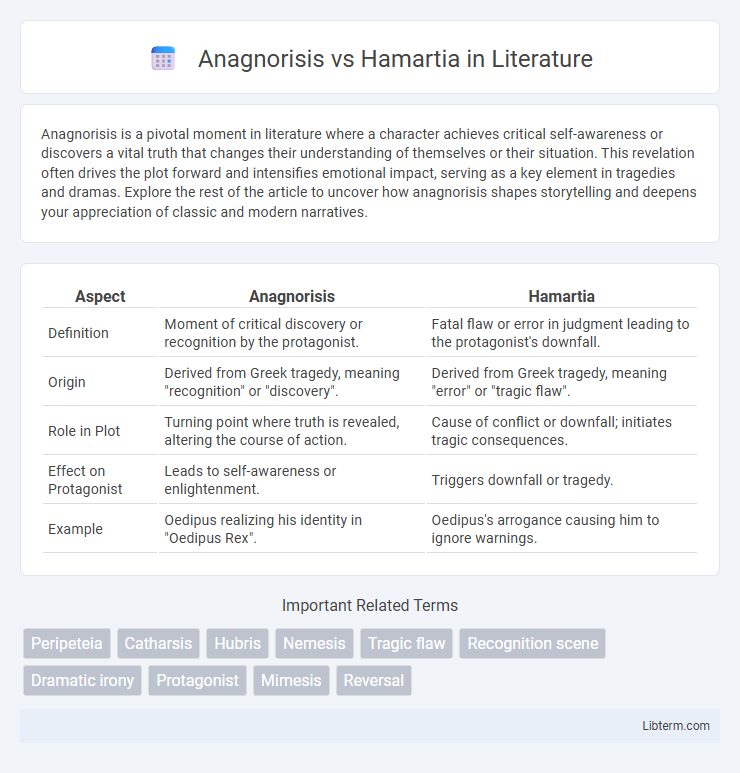Anagnorisis is a pivotal moment in literature where a character achieves critical self-awareness or discovers a vital truth that changes their understanding of themselves or their situation. This revelation often drives the plot forward and intensifies emotional impact, serving as a key element in tragedies and dramas. Explore the rest of the article to uncover how anagnorisis shapes storytelling and deepens your appreciation of classic and modern narratives.
Table of Comparison
| Aspect | Anagnorisis | Hamartia |
|---|---|---|
| Definition | Moment of critical discovery or recognition by the protagonist. | Fatal flaw or error in judgment leading to the protagonist's downfall. |
| Origin | Derived from Greek tragedy, meaning "recognition" or "discovery". | Derived from Greek tragedy, meaning "error" or "tragic flaw". |
| Role in Plot | Turning point where truth is revealed, altering the course of action. | Cause of conflict or downfall; initiates tragic consequences. |
| Effect on Protagonist | Leads to self-awareness or enlightenment. | Triggers downfall or tragedy. |
| Example | Oedipus realizing his identity in "Oedipus Rex". | Oedipus's arrogance causing him to ignore warnings. |
Understanding Anagnorisis: A Definition
Anagnorisis is the critical moment of recognition or discovery in a tragedy, where the protagonist gains essential insight into their true nature or situation, often leading to a reversal of fortune. Unlike hamartia, which refers to a protagonist's tragic flaw or error causing their downfall, anagnorisis signifies awareness and knowledge that precipitates change in the narrative. This concept, rooted in Aristotelian poetics, is pivotal in understanding character development and thematic depth in classical and modern literature.
What is Hamartia? Key Concept Explained
Hamartia refers to a tragic flaw or error in judgment that leads to the protagonist's downfall in classical tragedy, often rooted in inherent character weaknesses such as hubris or impulsiveness. This concept, central to Aristotle's Poetics, highlights how a single misstep or moral failing triggers the chain of events culminating in catastrophe. Understanding hamartia is crucial for analyzing the moral complexity and fate-driven consequences within tragic narratives.
Differences Between Anagnorisis and Hamartia
Anagnorisis refers to the critical moment of recognition or discovery in a narrative when a character gains essential knowledge about their true situation or identity, significantly impacting the plot's direction. Hamartia, on the other hand, denotes a character's fatal flaw or error in judgment that leads to their downfall, often rooted in personality traits or decisions. The primary difference lies in anagnorisis being a cognitive revelation, while hamartia represents the inherent character defect causing the tragic outcome.
The Role of Anagnorisis in Classical Tragedy
Anagnorisis, the moment of critical discovery or recognition, serves as a pivotal turning point in classical tragedy, often illuminating the protagonist's hamartia or fatal flaw. This revelation intensifies the emotional impact by transforming ignorance into knowledge, prompting a profound shift in the character's understanding and fate. The interplay between anagnorisis and hamartia drives the tragic narrative, deepening themes of human fallibility and moral insight in works by playwrights like Sophocles and Aristotle's Poetics.
How Hamartia Drives Tragic Action
Hamartia, often defined as a tragic flaw or error in judgment, drives the plot by propelling the protagonist into irreversible conflict and suffering. This critical mistake triggers a chain of events that lead to the hero's downfall, distinguishing it from anagnorisis, which represents the moment of tragic recognition or insight. Shakespeare's Othello exemplifies hamartia through Othello's jealousy, causing misguided actions that fuel the tragedy's progression and ultimate demise.
Famous Examples of Anagnorisis in Literature
Oedipus Rex by Sophocles features one of the most iconic instances of anagnorisis, where Oedipus realizes his true identity and unwittingly fulfills the prophecy of patricide and incest. In Shakespeare's King Lear, the moment of anagnorisis occurs when Lear recognizes his folly in misjudging his daughters, leading to his tragic downfall. Another famous example is found in Charles Dickens' Great Expectations, where Pip experiences anagnorisis upon discovering the true source of his wealth and the reality of his benefactor.
Notable Cases of Hamartia in Classic Works
Hamartia, the tragic flaw leading to the protagonist's downfall, is exemplified by characters such as Oedipus in Sophocles' "Oedipus Rex," whose ambition and blindness to truth trigger his ruin. In Shakespeare's "Macbeth," Macbeth's excessive ambition and moral weakness drive the plot toward catastrophe. These classic works illustrate how hamartia shapes the tragic narrative by intensifying conflict and evoking catharsis in the audience.
Interplay of Anagnorisis and Hamartia in Tragedy
Anagnorisis and hamartia are central to the structure of classical tragedy, where hamartia refers to the protagonist's fatal flaw or error in judgment that sets the catastrophic events in motion. The moment of anagnorisis occurs when the tragic hero experiences a critical discovery or recognition, often realizing the consequences of their hamartia and the true nature of their predicament. This interplay heightens dramatic tension and emotional impact, as the hero's self-awareness deepens the tragedy by juxtaposing their flaw with newfound insight, driving the narrative toward its inevitable downfall.
Impact on Character Development and Plot
Anagnorisis, the moment of critical self-awareness, drives character development by revealing hidden truths that often shift a protagonist's motivations and decisions, deepening psychological complexity. Hamartia, a fatal flaw or error in judgment, propels the plot by initiating conflict and tragedy, making the character's downfall inevitable and more impactful. Together, anagnorisis and hamartia create a dynamic interplay where the protagonist's recognition of their flaw heightens emotional stakes and advances narrative tension.
Modern Perspectives on Anagnorisis and Hamartia
Modern perspectives on anagnorisis emphasize its role as a transformative moment of self-awareness that drives character development and narrative depth, often linked with psychological realism and emotional complexity. Contemporary interpretations of hamartia expand beyond classical notions of a fatal flaw to include cognitive biases, moral dilemmas, and environmental influences shaping tragic errors. Scholars analyze anagnorisis and hamartia through interdisciplinary lenses, highlighting their relevance in modern storytelling, film, and psychological studies.
Anagnorisis Infographic

 libterm.com
libterm.com